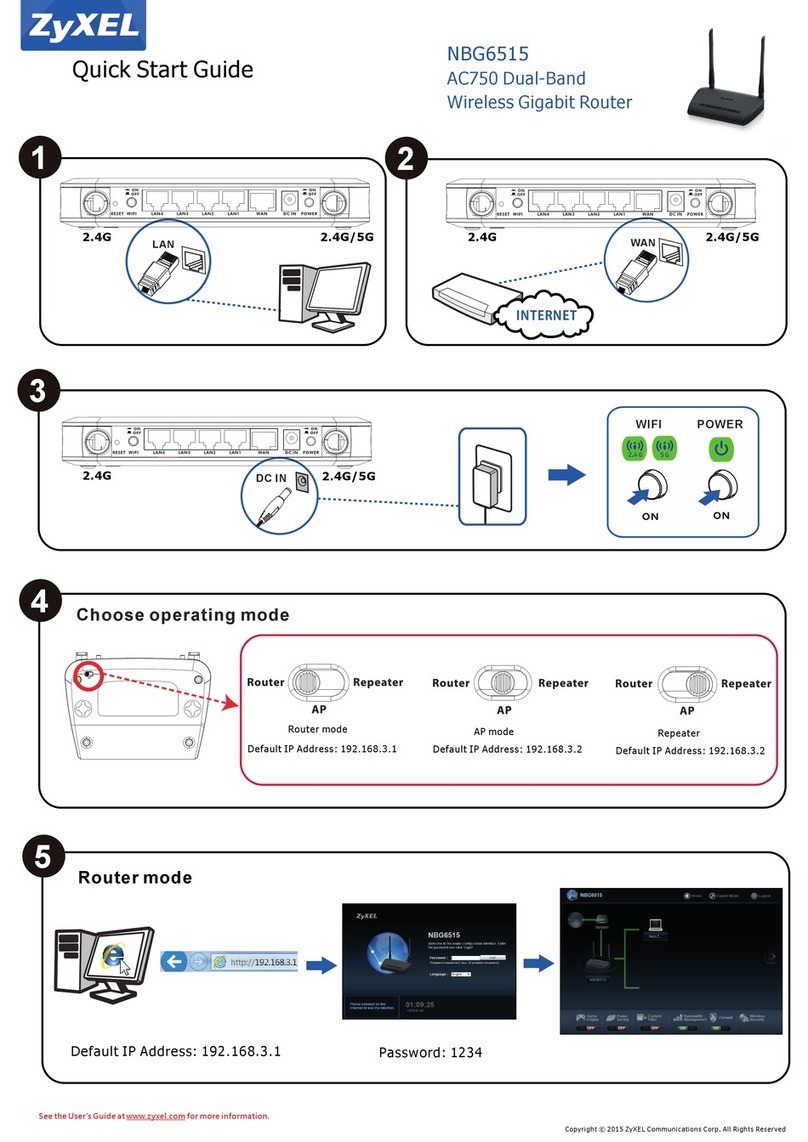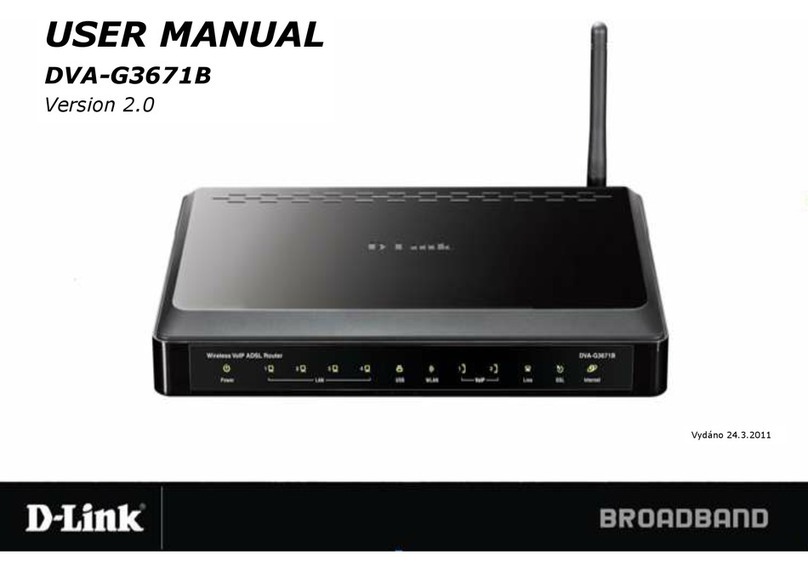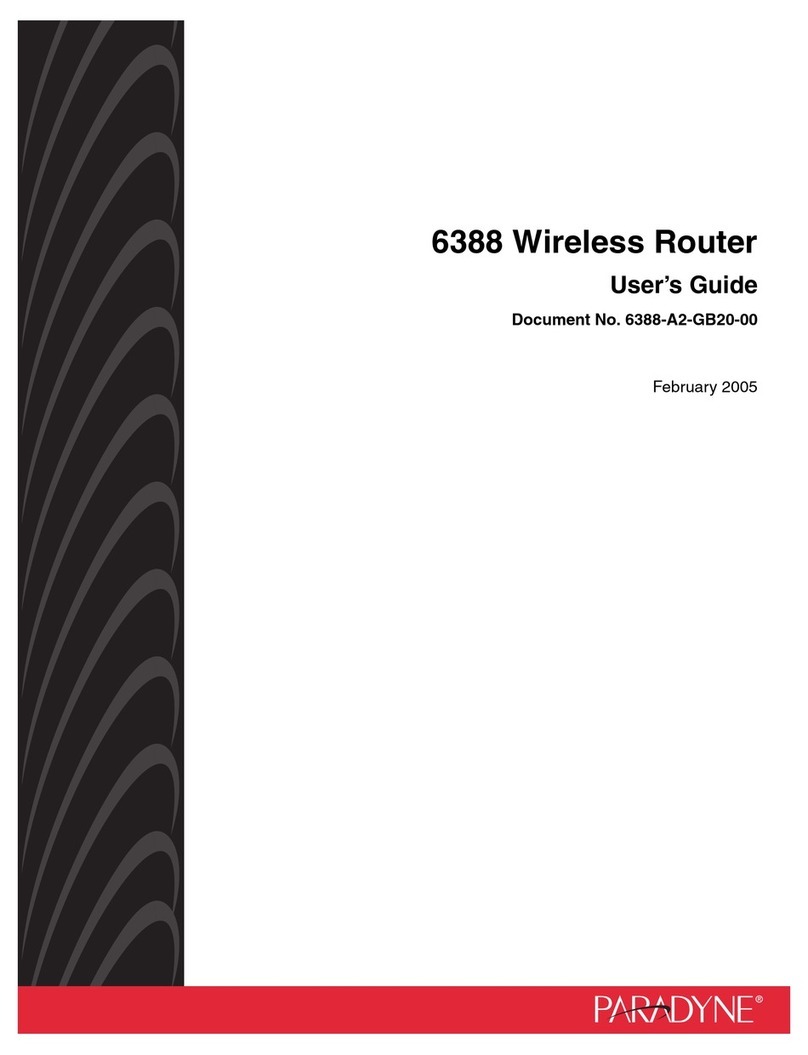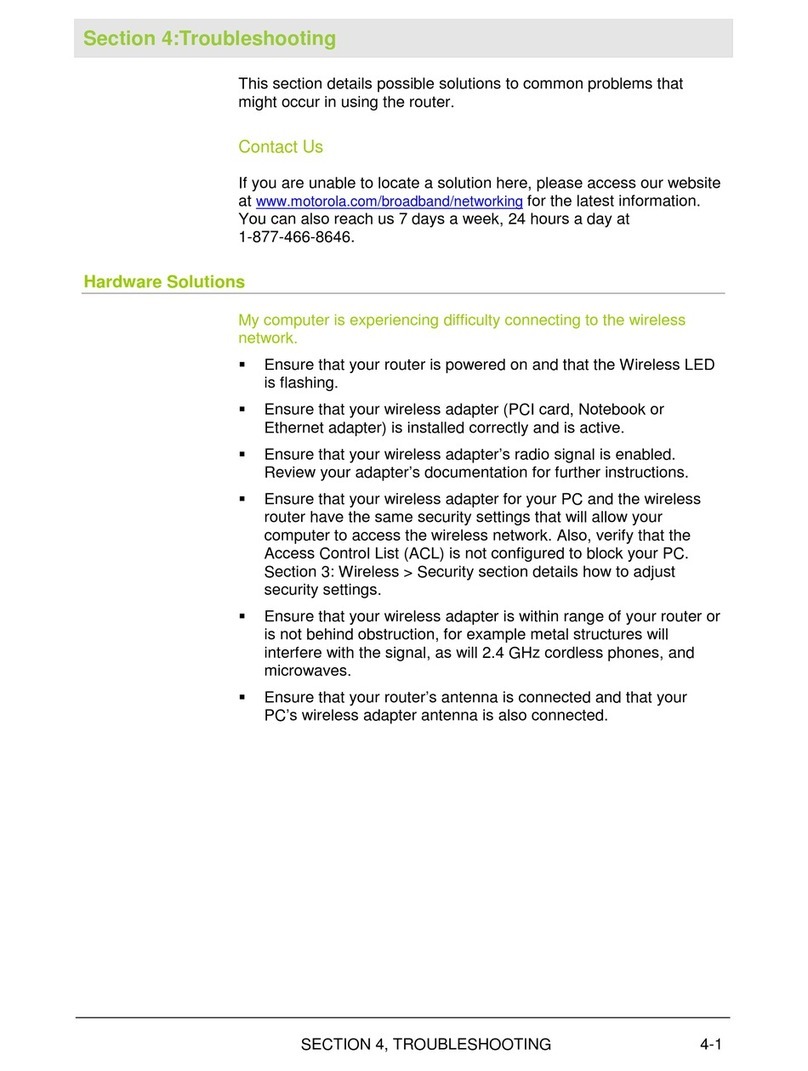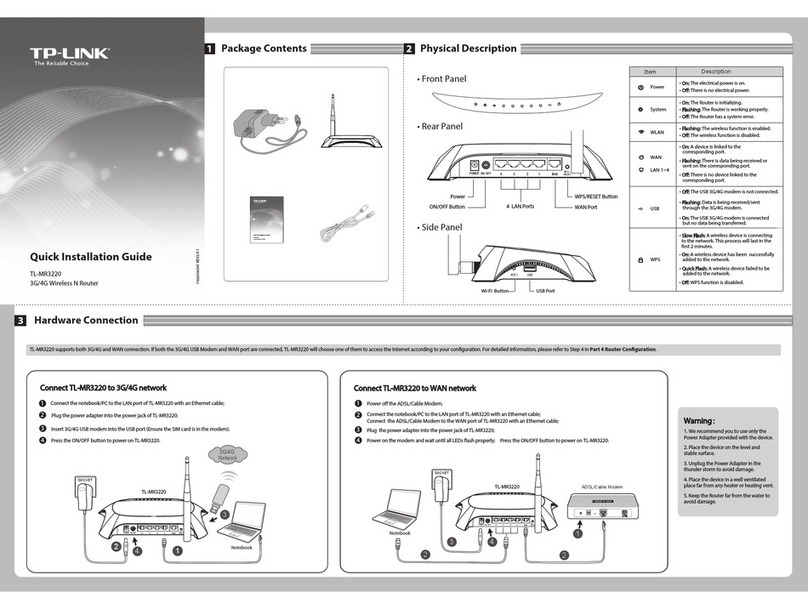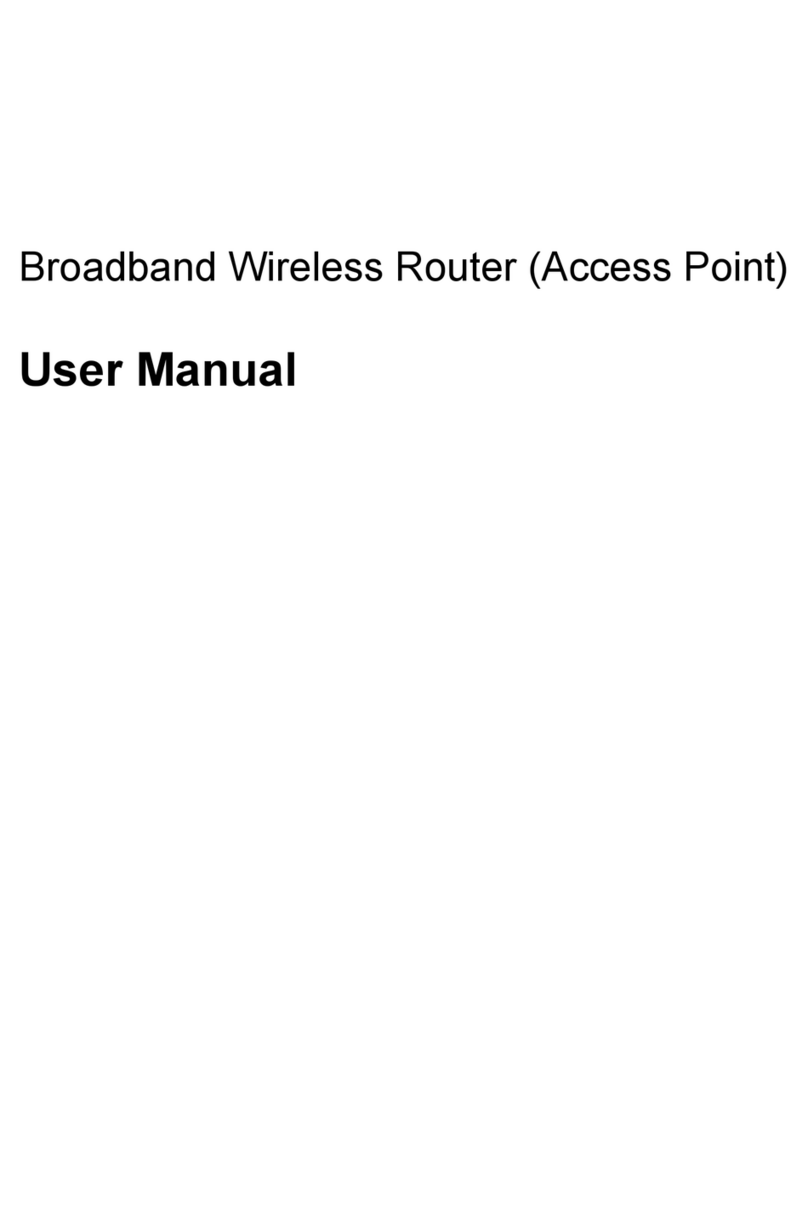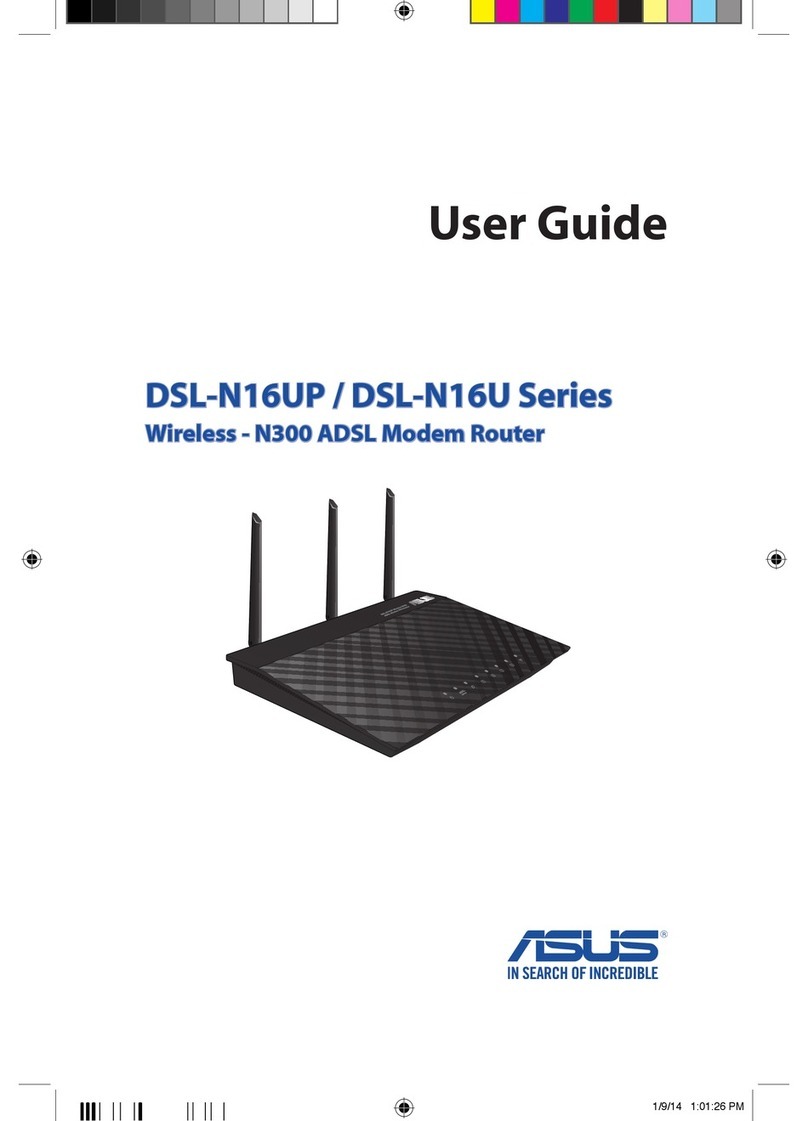ASIX AXM22001-2A-C User manual

1
AXM22001-2A-C
IEEE 802.11b/g WiFi Module Board User’s Guide
Copyright © 2011 ASIX Electronics Corporation. All rights reserved.
The AXM22001-2A-C is a 2.4GHz 802.11b/g WiFi module
board which integrates AX22001 and Airoha AL2230S RF
transceiver on board to provide a complete WiFi module
solution with various user or host interfaces supported. The
AXM22001-2A-C is a surface mountable module with
castellated mounting holes which offers smaller-form-factor,
lower-cost, pre-calibrated RF front-end and pre-certified WiFi
module board to free the user from RF and antenna design
tasks and regulatory compliance testing, ultimately providing
quicker time to market. The user can design his host board with
desired function and interface circuits and assemble it with the
AXM22001-2A-C WiFi module board through the castellated
mounting holes.
Key Features
yIntegrated 2.4GHz, IEEE 802.11b/g compatible
WiFi connectivity
yIntegrated PCB antenna
yMax outdoor range up to 300m (984 ft.), line of
sight
ySupports operation in Infrastructure or Ad-Hoc
(IBSS) network topology
ySupports 802.11i security: WEP-64/128, TKIP
(WPA-PSK) and AES (WPA2-PSK)
yDual 8-bit 1T 8051/80390 CPU @ 80MHz
y1MB shared Flash memory for MCPU and
WCPU program code and configuration data
storage
y64KB data memory for MCPU
y4 UART interfaces
yHigh Speed SPI interface (master or slave
mode)
yI2S or PCM interface
yLocal Bus host interface (master or slave mode)
yMII or RMII interface
yI2C interface
yUp to 32 GPIOs (4 GPIO ports of 8 bits each)
ySupports real-time clock, with option to use
independent power supply from lithium battery
ySupports TCP, UDP, ICMP, IGMP, IPv4,
DHCP, BOOTP, ARP, DNS, SMTP, SNTP,
UPnP, PPPoE and HTTP in software
ySupports network boot over Ethernet or WiFi
using BOOTP and TFTP
ySingle operating voltage: 3.3V typical
yBoard size: 51.0mm x 28.0mm x 4.5mm
surface mountable module
Applications
ySerial to WiFi Device Server
yWiFi Speaker
yWiFi Remote Control/Monitor
yEthernet to WiFi Bridge
yZigbee to WiFi Bridge
yWiFi Network Camera
yWiFi RFID
ySPI to WiFi Bridge
yTCP/IP and WLAN Offload Co-processor
yWiFi Internet Radio
Model Name: AXM22001-2A-C Document No: AXM22001-2A-C/V1.01/11/07/11

2
AXM22001-2A-C
IEEE 802.11b/g WiFi Module Board User’s Guide
Copyright © 2011 ASIX Electronics Corporation. All rights reserved.
Pinout Diagram of Castellated Mounting Holes
Figure 1. Module pinout
3V3_PAS
3V3_PAS
GND
GND
GND
GND
GND
P20
P21
P22
P23
P24
P25
P26
P27
XTL32KO
XTL32KI
VCC18A_RTCI
1V8
LB_CL
K
WLED
SYSCK_SEL
XDATA1
XDATA2
XDATA4
XDATA5
XDATA6
RST_N
GND
GND
GND
GND
GND
3V3_RF
3V3_RF
P30
P31
P32
P33
P34
P35
P36
P37
MISO
MOSI
SCLK
RSTO_N
SS0
SS2
SS1
INT1
INT0
TXD0
RXD0
P17
P16
P15
P14
XDATA7
P00
P01
P02
P03
P04
P05
P06
P07
P10
P11
P12
P13
SD
A
SCL
GND
3V3
3V3
GND
GND

3
AXM22001-2A-C
IEEE 802.11b/g WiFi Module Board User’s Guide
Copyright © 2011 ASIX Electronics Corporation. All rights reserved.
Pin Description of Castellated Mounting Holes
Pin type abbreviation:
PI: Power input PO: Power output G: Ground
B: Bidirectional signal pin I: Input signal pin O: Output signal pin
Module
Pin No Schematic
Symbol Pin No Pin Name Pin
Type Description
1 J3.1 3V3_PAS PI 3.3V power input for RF power amplifier
2 J3.2 3V3_PAS PI 3.3V power input for RF power amplifier
3 J3.3 GND G Ground
4 J3.4 GND G Ground
5 J3.5 GND G Ground
6 J2.1 GND G Ground
7 J2.2 GND G Ground
8 J2.3 P20*B P20 / LA5 / RXD1 / MDC signals
9 J2.4 P21*B P21 / LA6 / TXD1 / MDIO signals
10 J2.5 P22*B P22 / LA7 / WRXD0 signals
11 J2.6 P23*B P23 / LALE / PCLK / WTXD0 signals
12 J2.7 P24*B P24 / LRDY / DVP_RDY / RXD3 / TM0_CK signals
13 J2.8 P25*B P25 / LINT / TXD3 / TM0_GT signals
14 J2.9 P26*B P26 / LLDS_N / RXD2 / TM1_CK signals
15 J2.10 P27*B P27 / LUDS_N / TXD2 / TM1_GT signals
16 J2.11 XTL32KO O 32.768KHz crystal output
17 J2.12 XTL32KI I 32.768KHz crystal input
18 J2.13 VCC18A_RTCI PI 1.8V power input for 32.768KHz crystal I/O and RTC logic
19 J2.14 1V8 PO 1.8V power output
20 J2.15 LB_CLK B Local bus clock input or output
21 J2.16 WLED*O WiFi link status LED
22 J2.17 SYSCK_SEL I Operating system clock frequency selection input
23 J2.18 XDATA1 B XDATA1 / LB_MOD configuration
24 J2.19 XDATA2 B XDATA2 / SYNC_BUS configuration
25 J2.20 XDATA4 B XDATA4 / BURN_FLASH_EN configuration
26 J2.21 XDATA5 B XDATA5 / BURN_FLASH_921K configuration
27 J2.22 XDATA6 B XDATA6 / I2C_BOOT_DIS configuration
28 J2.23 RST_N I Module reset input
29 J2.24 GND G Ground
30 J1.1 XDATA7 B XDATA7 / REV_EN configuration
31 J1.2 P00*B P00 / LA8 / DE3 / TX_CLK / REFCKO signals
32 J1.3 P01*B P01 / LA9 / RE3_N / MTXD0 signals
33 J1.4 P02*B P02 / LA10 / CTS3 / MTXD1 signals
34 J1.5 P03*B P03 / LA11 / DSR3 / TX_EN signals
35 J1.6 P04*B P04 / LA12 / RI3 / RX_CLK / REFCKI signals
36 J1.7 P05*B P05 / LA13 / DCD3 / MRXD0 signals
37 J1.8 P06*B P06 / LA14 / RTS3 / MRXD1 signals
38 J1.9 P07*B P07 / LA15 / DTR3 / RX_DV / CRS_DV signals
39 J1.10 P10*B P10 / LA0 / MCLK / MTXD2 signals
40 J1.11 P11*B P11 / LA1 / BCKT / MTXD3 signals
41 J1.12 P12*B P12 / LA2 / WST / TX_ER signals
42 J1.13 P13*B P13 / LA3 / DATAT / COL signals
43 J1.14 SDA B I2C serial clock
44 J1.15 SCL B I2C serial data
45 J1.16 GND G Ground
46 J1.17 3V3 PI 3.3V power input
47 J1.18 3V3 PI 3.3V power input
48 J1.19 GND G Ground

4
AXM22001-2A-C
IEEE 802.11b/g WiFi Module Board User’s Guide
Copyright © 2011 ASIX Electronics Corporation. All rights reserved.
49 J1.20 GND G Ground
50 J4.1 P14*B P14 / LA4 / BCKR / MRXD2 signals
51 J4.2 P15*B P15 / LRD_N / WSR / MRXD3 signals
52 J4.3 P16*B P16 / LWR_N / DATAR / RX_ER signals
53 J4.4 P17*B P17 / LCS0_N / HREF / CRS signals
54 J4.5 RXD0 B MCPU UART 0 serial receive data
55 J4.6 TXD0 O MCPU UART 0 serial transmit data
56 J4.7 INT0*B INT0 / XWKUP / LDA8 / SINT / DB_DI signals
57 J4.8 INT1*B INT1 / WINT0 / LDA9 / SRDY / DB_CKO signals
58 J4.9 SS1*B SS1 / LDA10 / STPZ / DB_DO signals
59 J4.10 SS2*B SS2 / LDA11 / DQ / MINT_N signals
60 J4.11 SS0*B SS0 / LDA12 signals
61 J4.12 RSTO_N O Reset output
62 J4.13 SCLK*B SCLK / LDA13 / WDB_DI signals
63 J4.14 MOSI*B MOSI / LDA14 / WDB_CKO signals
64 J4.15 MISO*B MISO / LDA15 / WDB_DO signals
65 J4.16 P37*B P37 / LDA7 / Y7 / DTR2 / CEX4 signals
66 J4.17 P36*B P36 / LDA6 / Y6 / RTS2 / CEX3 signals
67 J4.18 P35*B P35 / LDA5 / Y5 / DCD2 / CEX2 signals
68 J4.19 P34*B P34 / LDA4 / Y4 / RI2 / CEX1 signals
69 J4.20 P33*B P33 / LDA3 / Y3 / DSR2 / CEX0 signals
70 J4.21 P32*B P32 / LDA2 / Y2 / CTS2 / ECI signals
71 J4.22 P31*B P31 / LDA1 / Y1 / RE2_N / TM2_GT signals
72 J4.23 P30*B P30 / LDA0 / Y0 / DE2 / TM2_CK signals
73 J4.24 3V3_RF PI 3.3V power input for RF circuit
74 J4.25 3V3_RF PI 3.3V power input for RF circuit
75 J4.26 GND G Ground
76 J4.27 GND G Ground
77 J4.28 GND G Ground
78 J4.29 GND G Ground
Note:
* These pins are multi-function pins in AX22001. Please refer to Section 3.1.3 “Multi-function Pin Setting
(0x07 ~ 0x02)” on AX22001 datasheet to configure proper pin functions for your AX22001 application.
Please feel free to contact ASIX Electronics Technical Support ([email protected]) to receive AXM22001-2A-C
WiFi module board schematic and BOM file for details.

5
AXM22001-2A-C
IEEE 802.11b/g WiFi Module Board User’s Guide
Copyright © 2011 ASIX Electronics Corporation. All rights reserved.
Board Dimensions
The AXM22001-2A-C is a surface mountable module with castellated mounting holes on three sides. Below shows the
module dimensions.
Figure 2. Module Dimension
51.04mm
28.0mm

6
AXM22001-2A-C
IEEE 802.11b/g WiFi Module Board User’s Guide
Copyright © 2011 ASIX Electronics Corporation. All rights reserved.
Host PCB Footprint
Below shows the recommended host PCB footprints for the module. The AXM22001-2A-C module has an integrated
PCB antenna which requires the host PCB to maintain certain copper keep-out area as shown below, for best antenna
performance. Also, when mounting on the host PCB of user’s system, the module’s PCB antenna should be on the edge
of the host PCB and faced outward.
Figure 3. Layout Footprint & layout guide

7
AXM22001-2A-C
IEEE 802.11b/g WiFi Module Board User’s Guide
Copyright © 2011 ASIX Electronics Corporation. All rights reserved.
Module Reflow Profile
Zone #AD1 #AD2 #AD3 #AD4 #AD5 #AD6 #AD7 #AD8
Upper Limit(℃) 170 175 185 190 195 225 275 260
Lower Limit(℃) 170 0 0 0 0 225 275 260
Time (S) 50 50 50 50 50 50 50 50
Figure 4. Module Reflow
Conve
y
or Speed: 70 cm/min

8
AXM22001-2A-C
IEEE 802.11b/g WiFi Module Board User’s Guide
Copyright © 2011 ASIX Electronics Corporation. All rights reserved.
PCB Antenna
One of the main reasons to use a PCB antenna is to reduce cost. Since the antennas is fabricated on the top layer with
solder mask. Other layers below the antenna have no copper trace and plane. It is recommended that the module be
mounted on the edge of the host PCB. To have best performance, place the module on the host PCB according to the
details shown in Figure 3. The antenna patterns are shown in the Figure 5 and Figure 6. These patterns allow the designer
to understand the performance of the module with respect to the position of the receive/transmit antenna at the other end
of the link.
Figure 5. Module in horizontal antenna pattern
Figure 6. Module in vertical antenna pattern

9
AXM22001-2A-C
IEEE 802.11b/g WiFi Module Board User’s Guide
Copyright © 2011 ASIX Electronics Corporation. All rights reserved.
Regulatory Approval
The AXM22001-2A-C module has acquired the regulatory approvals for modular devices in the United States. Modular
approval allows the user to mount the AXM22001-2A-C module inside his own final product and needn’t the regulatory
testing, if no changes or modifications to the module circuitry. Any changes or modifications will cause the user to lose
his authority to operate the equipment. The user must comply with all of the instructions provided by ASIX Electronics,
which indicate the necessary of the installation and/or operating conditions for the compliance.
The integrator still has the responsibility to test the end product for any additional compliance (for example: digital
device emission, PC peripheral requirements, etc.) in the specific country that the end product will be sold.
United States
The AXM22001-2A-C module has complied with part 15 subpart C “Intentional Radiators” 15.247, 15.207 and 15.209
of the FCC Rules. And modular approval with FCC part 15.212. The module can be integrated into a finished product
without obtaining subsequent and separate FCC approvals. For product available in the USA market, only channel 1~11
can be operated. Selection of other channels is not possible.
FCC Statement:
This equipment has been tested and found to comply with the limits for a Class B digital device, pursuant to
part 15 of the FCC Rules. These limits are designed to provide reasonable protection against harmful
interference in a residential installation. This equipment generates, uses and can radiate radio frequency energy,
and if not installed and used in accordance with the instructions, may cause harmful interference to radio
communications. However, there is no guarantee that interference will not occur in a particular installation. If
this equipment does cause harmful interference to radio or television reception, which can be determined by
turning the equipment off and on, the user is encouraged to try to correct the interference by one or more of the
following measures:
•Reorient or relocate the receiving antenna.
•Increase the separation between the equipment and receiver.
•Connect the equipment into an outlet on a circuit different from that to which the receiver is connected.
•Consult the dealer or an experienced radio/TV technician for help
The user’s manual or datasheet of the end product should include the above statement.
FCC Caution
To ensure continued compliance, (1) Any changes or modifications not expressly approved by the party
responsible for compliance could void the user’s authority to operate this equipment. (2)This device must not be
co-located or operating in conjunction with any other antenna or transmitter.
Co-location with other radio transmitting devices operating concurrently in the same band will require
additional testing and certification.
FCC Notice
This device complies with Part 15 of the FCC Rules. Operation is subject to the following two conditions:
1.This device may not cause harmful interference.
2.This device must accept any interference received, including interference that may cause undesired
operation.

10
AXM22001-2A-C
IEEE 802.11b/g WiFi Module Board User’s Guide
Copyright © 2011 ASIX Electronics Corporation. All rights reserved.
FCC Label requirement:
If the FCC ID is not visible when the module is installed inside another device, then the outside of the device
into which the module is installed must also display a label referring to the enclosed module. This exterior label
can use wording such as the following: “Contains Transmitter Module FCC ID: Z59A22001C” or “Contains
FCC ID: Z59A22001C.” Any similar wording that expresses the same meaning may be used.
Contains Transmitter Module FCC ID: Z59A22001C
or
Contains FCC ID: Z59A22001C
RF Exposure:
The following statement must be included as a CAUTION statement in manuals and OEM products to alert
users of FCC RF exposure compliance:
To satisfy FCC RF Exposure requirements for mobile
and base station transmission devices, the distance
between the antenna of for this device and the persons
must be 20 cm or more during operation.
This device must not be co-located or operating in
conjunction with any other antenna or transmitter.
If the AXM22001-2A-C module is used in a portable application (i.e., the antenna is less than 20 cm from
persons during operation), the integrator is responsible for performing Specific Absorption Rate (SAR) testing
in accordance with FCC rules 2.1091.
Helpful Web Sites:
Federal Communications Commission (FCC): http://www.fcc.gov
Europe
The AXM22001-2A-C module has been certified for using in European countries. The following testing has been
completed:
Test standard ETSI EN 300 328 V1.7.1 (2006):
•Equivalent Isotropic Radiated Power
•Maximum Spectral Power Density
•Frequency Range
•Transmitter Spurious Emissions
•Receiver Spurious Emissions
Test standards ETSI EN 301 489-1:2008 and ETSI EN 301 489-17:2009:
•Radiated Emissions
•Electrostatic Discharge (ESD)
•RF Electromagnetic Field (RS)
The modules are fully compliant with
•Radiated Emissions EN 55022
•Electrostatic Discharge EN 61000-4-2
•RF Electromagnetic Field EN 61000-4-3

11
AXM22001-2A-C
IEEE 802.11b/g WiFi Module Board User’s Guide
Copyright © 2011 ASIX Electronics Corporation. All rights reserved.
ETSI does not provide a modular approval service. However, the testing completed above included the test plan, test
results and can be the reference for the certification. The end user is responsible for ensuring compliance with
harmonized frequencies and labeling requirements for each country in which the end device is marketed and sold.
Helpful Web Sites:
Radio and Telecommunications Terminal Equipment (R&TTE):http://ec.europa.eu/enterprise/rtte/index_en.htm
European Conference of Postal and Telecommunications Administrations (CEPT):http://www.cept.org/
European Telecommunications Standards Institute (ETSI): http://www.etsi.org/
European Radio Communications Office (ERO): http://www.ero.dk/
Table of contents
Popular Wireless Router manuals by other brands
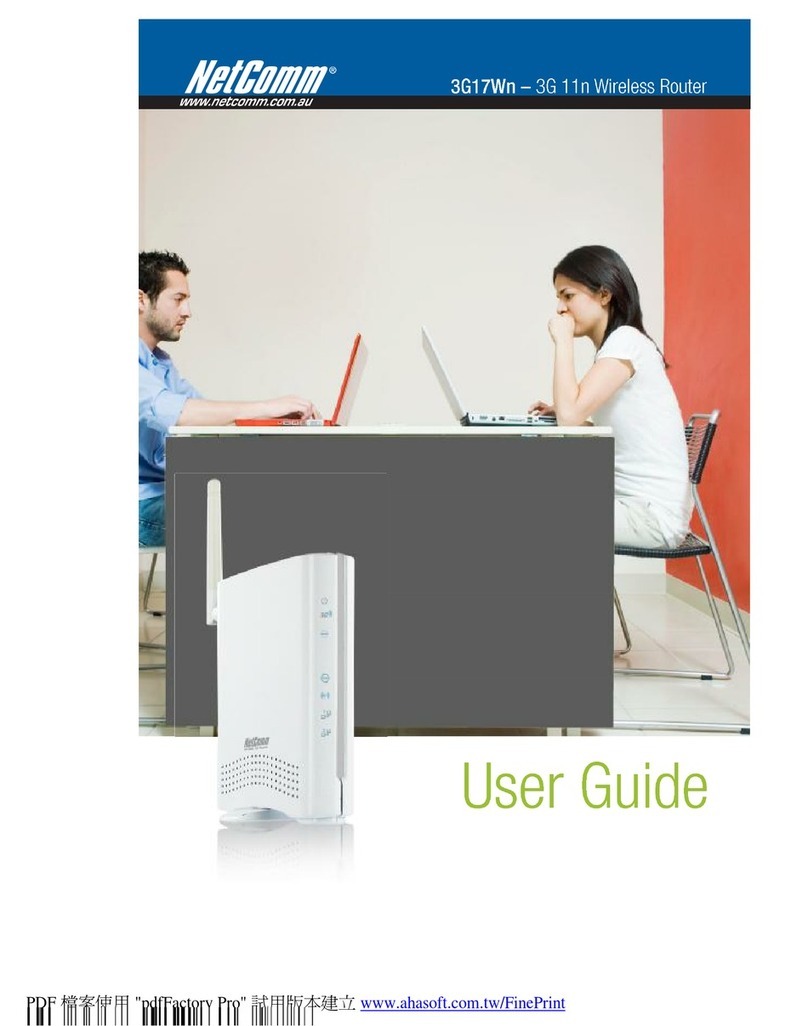
NetComm
NetComm Liberty 3G17Wn user guide
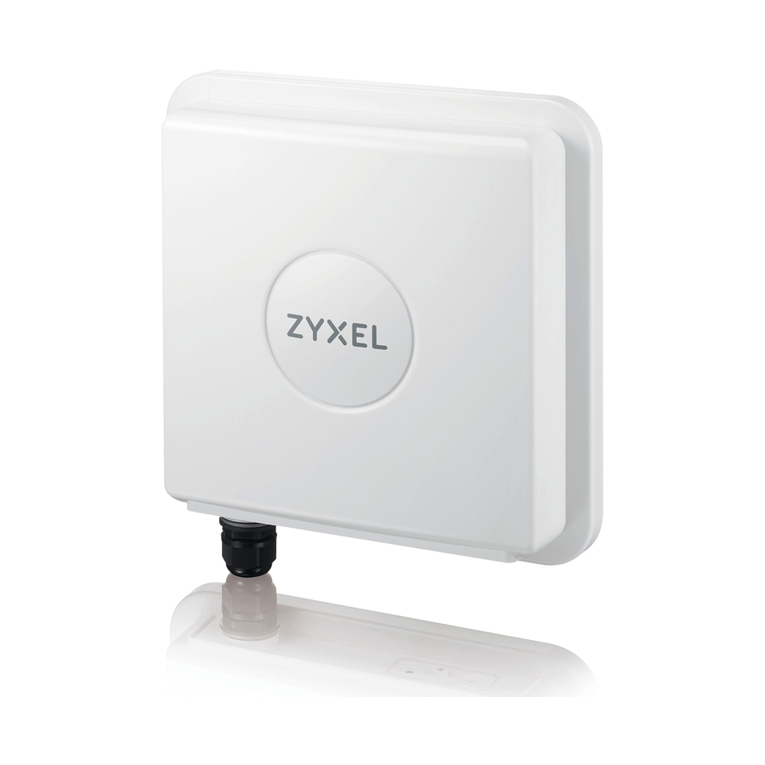
ZyXEL Communications
ZyXEL Communications LTE7461-M602 user guide
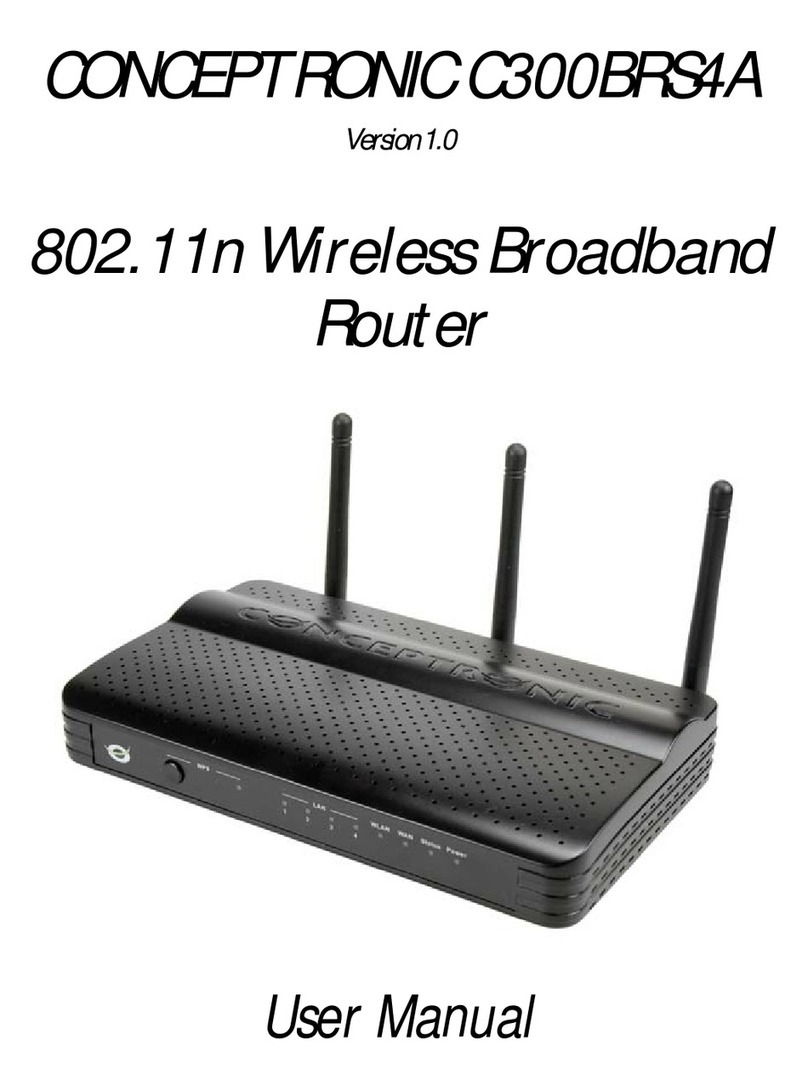
Conceptronic
Conceptronic 802.11n Wireless Broadband Router C300BRS4A user manual
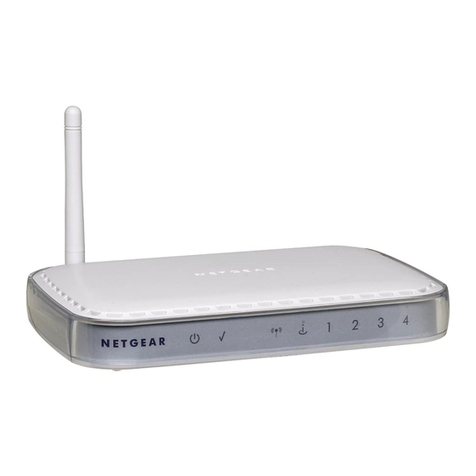
NETGEAR
NETGEAR WGT624v4 - 108 Mbps Wireless Firewall Router Reference manual

Canyon
Canyon CN-BTU4 user manual
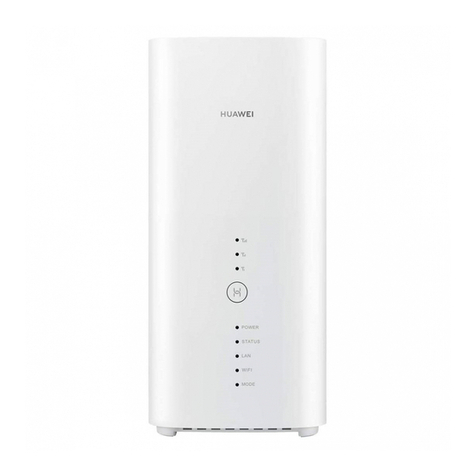
Huawei
Huawei B818-263 QUICK STAR
